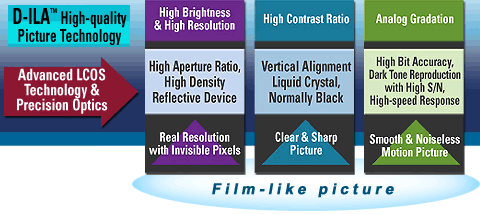
| Structure of D-ILA(R) |
|
The D-ILA(R) (Digital Direct Drive Image
Light Amplifier) technology that JVC has developed is based on an
innovation in microchip design that permits the viewer to enjoy
the full range of benefits from any high quality source whether
from a video deck or a computer device. For true HDTV performance,
the D-ILA(R) technology packs up to 2048 x 1536 pixels -a total
of 3.2 million pixels- on a single 1.3" chip. What is the end result? Images as smooth and natural as film with impeccable reproduction of all the details and information contained in the original source. What supports this high picture quality is high brightness, high resolution, high contrast and analog gradation. High brightness and high resolution are achieved using a reflective device with a high aperture ratio and high-density pixels, providing real resolution with invisible pixels. High contrast is achieved using vertical alignment liquid crystals of normally black operation and a high-precision optical system. Analog gradation makes it possible to reproduce dark areas with high S/N (signal-to-noise ratio) because the D-ILA(R) device has an S-shape response. In combination with the high-speed response of the vertical alignment liquid crystal, JVC's D-ILA(R) technology makes it possible to reproduce smooth, noiseless motion pictures with clear, sharp high definition and film-like picture quality. |

|
|
 |